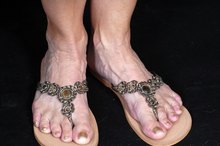Popliteal Aneurysm Symptoms
An aneurysm is a dilation or ballooning of an artery or other blood vessel which causes the walls of the blood vessel to become stretched and weakened, as described by Merck, an online medical library. A popliteal aneurysm occurs in the popliteal artery, which is behind the knee and carries blood from the thigh to the lower leg and feet. Diagnosis and treatment by a physician is important to treat and prevent blockages and other complications from arising.
If you are experiencing serious medical symptoms, seek emergency treatment immediately.
Pain
Although a popliteal aneurysm does not normally cause pain, it may cause discomfort and soreness in the area behind the knee, explains the University of Chicago Medical Center 2. This discomfort is particularly noticeable during standing for prolonged periods, walking and exercise. According to Dr. Y. Panayiotopoulos, a vascular specialist, pain during rest and inactivity is present in about 15 percent of individuals with severe thrombosis, or blockage of the popliteal artery due to an aneurysm 3.
Numbness and Tingling
Symptoms of an Aneurysm in the Ankle
Learn More
The University of Chicago Medical Center lists numbness and tingling around the knee, lower leg and foot as symptoms of a popliteal aneurysm 2. This occurs because the aneurysm impedes blood flow within the artery and may grow so large that it compresses nerves that travel along the artery to the lower leg and foot.
Ischemia
A popliteal aneurysm may cause poor blood circulation, or ischemia, in the lower leg and foot. Dr. Panayiotopoulos notes that approximately 8 percent of individuals with the condition have sever ischemia that results in decreased oxygen and nutrient flow to the lower leg and foot, muscle weakness, impaired skin wound healing and a bluish skin tone 3. Ischemia occurs because blood clots, or thrombosis, form within the popliteal aneurysm and block the flow of blood traveling down the leg to the foot. The blood clots may also break off to become emboli that flow to other arteries, capillaries or veins where they cause blockages.
- A popliteal aneurysm may cause poor blood circulation, or ischemia, in the lower leg and foot.
Edema
4 Signs You Might Have a Leg Aneurysm
Learn More
Edema, or swelling, is caused by a popliteal aneurysm due to decreased blood flow in the leg and the compression of the popliteal vein that runs parallel to the artery. This hinders blood from being carried from the lower leg and foot back to the heart, and also increases the risk of varicose veins in the legs. Some of the fluids from blood then get forced into the tissues above and around the knee and in the lower leg, ankle and foot. Dr. Panayiotopoulos notes that almost 20 percent of individuals with a popliteal aneurysm suffer from compression or blood clots in the veins, causing swelling of the veins and tissues around the foot and leg 3.
- Edema, or swelling, is caused by a popliteal aneurysm due to decreased blood flow in the leg and the compression of the popliteal vein that runs parallel to the artery.
- Panayiotopoulos notes that almost 20 percent of individuals with a popliteal aneurysm suffer from compression or blood clots in the veins, causing swelling of the veins and tissues around the foot and leg 3.
Related Articles
References
- Merck: Aneurysms
- Dr. Yiannis Panayiotopoulos: Leg Aneurysms
- Jiji PJ, Dcosta S, Nayak SR, et al. Hypoplastic posterior tibial artery and the enlarged peroneal artery supplying the posterior crural region: a rare variation. Jornal Vascular Brasileiro. 2008;7(3):272-274. doi:10.1590/s1677-54492008000300014
- Kassem MM, Gonzalez L. Popliteal Artery Aneurysm. Treasure Island, Fl: StatPearls Publishing; 2019.
- Jacks R, Degiannis E. Endovascular Therapy And Controversies In The Management Of Vascular Trauma. Scand J Surg. 2014;103(2):149-155. doi:10.1177/1457496914532248
- Kropman R, Kiela G, Moll F, de Vries J. Variations in Anatomy of the Popliteal Artery and Its Side Branches. Vasc Endovascular Surg. 2011;45(6):536-540. doi:10.1177/1538574411409065
- Popliteal Artery. Kenhub. Published 2019
- Popliteal Artery Entrapment Syndrome (PAES) | Cleveland Clinic. Cleveland Clinic. Published 2019.
- Wright L, Matchett W, Cruz C et al. Popliteal Artery Disease: Diagnosis and Treatment. RadioGraphics. 2004;24(2):467-479. doi:10.1148/rg.242035117
- Wright L, Matchett W, Cruz C et al. Popliteal Artery Disease: Diagnosis and Treatment. RadioGraphics. 2004;24(2):467-479. doi:10.1148/rg.242035117
Writer Bio
Noreen Kassem is a hospital doctor and a medical writer. Her articles have been featured in "Women's Health," "Nutrition News," "Check Up" and "Alive Magazine." Kassem also covers travel, books, fitness, nutrition, cooking and green living.








